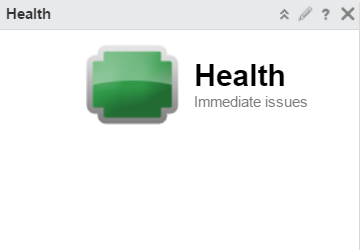The Health widget is the status of the health-related alerts for the objects it is configured to monitor in VMware Aria Operations. Health alerts usually require immediate attention. You can create one or more health widgets for different objects that you add to your custom dashboards.
How the Health Widget and Configuration Options Work
You can add the Health widget to one or more custom dashboards and configure it to display data that is important to the dashboard users. The information that it displays depends on how the widget is configured.

The state of the badge is based on your alert definitions. Click the badge to see the Summary tab for objects or groups configured in the widget. From the Summary tab, you can begin determining what caused the current state. If the widget is configured for an object that has descendants, you should also check the state of descendants. Child objects might have alerts that do not impact the parent.
If the Badge Mode configuration option is set to Off, the badge and a chart appears. The type of chart depends on the object that the widget is configured to monitor.
- A trend line displays the health status of the monitored object if the object does not provide its resources to any other object. For example, if the monitored object is a virtual machine or a distributed switch.
- A weather map displays the health of the ancestor and descendant objects of the monitored object for all other object types. For example, if the monitored object is a host that provides CPU and memory to a virtual machine.
If the Badge Mode is set to On, only the badge appears.
You edit a Health widget after you add it to a dashboard. The changes you make to the options create a custom widget that provides information about an individual object, a custom group of objects, or all the objects in your environment.
Where You Find the Health Widget
The widget might be included on any of your custom dashboards. From the left menu, click to see your configured dashboards.
To customize the data that appears in the dashboard widget, from the left menu, click . To create your dashboard, from the left menu, click . From the Dashboards panel, click Create. To edit your dashboard, from the left menu, click . From the Dashboards panel, select the dashboard you want to edit and select . Toggle between the Views and Widgets option to view and add a widget or view to the dashboard. The widgets list panel displays a list of all the predefined widgets. Drag a widget to the dashboard workspace in the upper panel.
Heath Widget Display Options
The Health widget displays a health badge. The widget also displays a health trend when not in badge mode.
| Option | Description |
|---|---|
| Health Badge | Status of the objects configured for this instance of the widget. Click the badge to open the Alerts tab for the object that provides data to the widget. If the Badge Mode option is off, a health weather map or trend chart appears for the object. Whether the map or chart appears depends on the object type. The health weather map displays tool tips for up to1000 objects. |
| Health Trend | Displays a chart, depending on the selected or configured object. The charts vary, depending on whether the monitored object is a group, a descendent object, or an object that provides resources to other objects. The chart appears only if the Badge Mode configuration option is off. If the Badge Mode is on, only the badge appears. |
Heath Widget Configuration Options
On the title bar of the widget, click the Edit Widget icon to configure the widget.
The configuration options are grouped into one or more sections. You can select the objects on which you want to base the widget data and refine the objects in the following sections. Each section filters the objects further and pushes the filtered objects to the next section. The widget data is based on the objects that are the output of the last section.
The Configuration section provides general configuration options for the widget.
The Input Data section provides options to specify input for the widget. This section appears when the widget is in self provider mode.
| Option | Description |
|---|---|
| Title | Enter a custom title that identifies this widget from other instances that are based on the same widget template. |
| Configuration | |
| Refresh Content | Activate or deactivate the automatic refreshing of the data in this widget. If not activated, the widget is updated only when the dashboard is opened or when you click the Refresh button on the widget in the dashboard. |
| Refresh Interval | If you activate the Refresh Content option, specify how often to refresh the data in this widget. |
| Self Provider |
Indicates whether the objects for which data appears in the widget are defined in the widget or provided by another widget.
|
| Badge Mode | Determines whether the widget displays only the badge, or the badge and a weather map or trend chart.
Select one of the following options:
|
| Input Data | |
| Object | Search for objects in your environment and select the object on which you are basing the widget data. You can also click the Add Object icon and select an object from the object list. You can use the Filter text box to refine the object list and the Tag Filter pane to select an object based on tag values. |